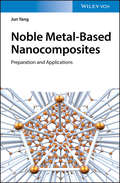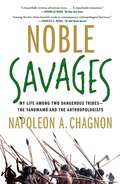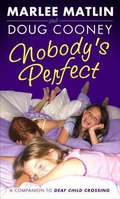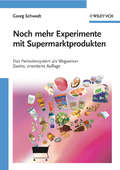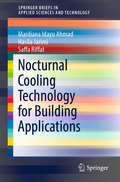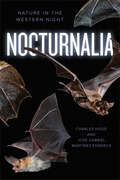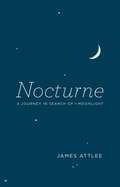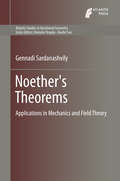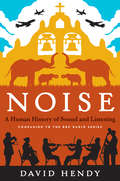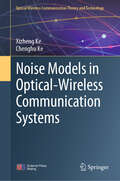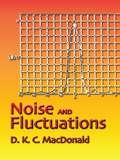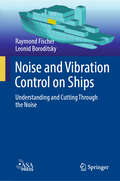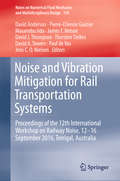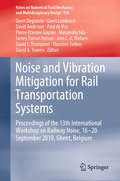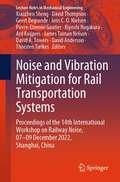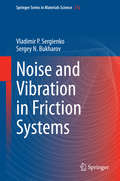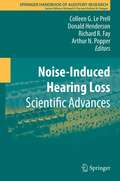- Table View
- List View
Noble Gas Chemistry: Structure, Bonding, and Gas-Phase Chemistry
by Felice GrandinettiAuthored by one of the world's leading experts in the chemistry of lighter noble gases, this comprehensive monograph fills the need for an up-to-date review of the diverse experimental techniques and theoretical methods currently in practice. After reviewing the experiments breaking the paradigm of "non-reactive" noble gases, the physico-chemical background is introduced. Besides the emphasis on gas phase reactions, the author presents other relevant systems, such as chemistry in the bulk phase, under high pressure, and cold matrices. The discussion of gas-phase chemistry of the noble gases covers neutral and ionic compounds, diatomic molecules, complexes with small molecules and metal compounds, up to large clusters.
Noble Metal Nanoparticles
by Ignác CapekThere is a growing interest in the use of nanoparticles modified with DNAs, viruses, peptides and proteins for the rational design of nanostructured functional materials and their use in biosensor applications. The challenge is to control the organization of biomolecules on nanoparticles while retaining their biological activity as potential chemical and gene therapeutics. These noble metal nanoparticles/biomolecules conjugates have specific properties and therefore they are attractive materials for nanotechnology in biochemistry and medicine. In this book, the author review work performed dealing with the DNA structure and functionalities, interactions between DNA, noble metal nanoparticles, surface active agents, solvents and other additives. Particular attention is given to how the DNA's chain length and the DNA conformation affect the interaction and structure of the nanoconjugates and nanostructures that are formed. Also discussed are the recent advances in the preparation, characterization, and applications of noble metal nanoparticles that are conjugated with DNA aptamers and oligomers. The advantages and disadvantages of functionalized nanoparticles through various detection modes are highlighted, including colorimetry, fluorescence, electrochemistry, SPR, and, mass spectrometry for the detection of small molecules and biomolecules. The functionalized noble metal nanoparticles are selective and sensitive for the analytes, showing their great potential in biosensing. Furthermore, this book reviews recent progress in the area of DNA-noble metal nanoparticles based artificial nanostructures, that is, the preparation, collective properties, and applications of various DNA-based nanostructures are also described.
Noble Metal-Based Nanocomposites: Preparation and Applications
by Jun YangProvides a systematic and coherent picture of the solution-based methods for the preparation of noble metal-based composite nanomaterials, their characterization, and potential applications in electrocatalysis Within the last decade, the development of wet-chemistry methods has led to the blossom of research in composite nanomaterials. However, the design and synthesis of composite nanomaterials with controlled properties remains a significant challenge. This book summarizes the solution-based methods for the preparation of noble metal-based composite nanomaterials. It examines their characterization, as well as their use in electrocatalysis. It also discusses the intrinsic relationship between the catalytic properties and the physical /chemical effects in the composite materials, and offers some perspectives for the future development of metal-based composite nanomaterials. In addition, the book not only provides a systematic and coherent picture of this field, but also inspires rethinking of the current processing technologies. Noble Metal-Based Nanocomposites: Preparation and Applications offers in-depth chapter coverage of ethanol-mediated phase transfer of metal ions and nanoparticles. It presents the full range of nanocomposites consisting of chalcogenide semiconductors and gold, silver sulfide, or other noble metals. It also examines core-shell structured cadmium selenide-platinum nanocomposites; Pt-containing Ag2S-noble metal nanocomposites for direct methanol fuel cells operated at high fuel concentrations; and nanocomposites consisting of metal oxides and noble metals. In addition, the book looks at scientific issues derived from noble metal-based nanocomposites. -Covers all of the preparations of noble metal-based nanocomposites and their numerous applications -Highlights some of the recent breakthroughs in the design, engineering, and applications of noble metal-based nanocomposites -Appeals to a wide range audience, especially researchers in the areas of catalysis, chemistry, chemical engineering, materials synthesis and characterization, and fuel cell Noble Metal-Based Nanocomposites: Preparation and Applications is an excellent book for inorganic chemists, materials scientists, catalytic chemists, chemical engineers, and those interested in the subject.
Noble Savages: My Life Among Two Dangerous Tribes -- The Yanomamo and the Anthropologists
by Napoleon ChagnonONE OF THE MOST IMPORTANT SCIENTIFIC MEMOIRS OF OUR TIME When Napoleon Chagnon arrived in Venezuela's Amazon region in 1964 to study the Yanomamö Indians, one of the last large tribal groups still living in isolation, he expected to find Rousseau's "noble savages," so-called primitive people living contentedly in a pristine state of nature. Instead Chagnon discovered a remarkably violent society. Men who killed others had the most wives and offspring, their violence possibly giving them an evolutionary advantage. The prime reasons for violence, Chagnon found, were to avenge deaths and, if possible, abduct women. When Chagnon began publishing his observations, some cultural anthropologists who could not accept an evolutionary basis for human behavior refused to believe them. Chagnon became perhaps the most famous American anthropologist since Margaret Mead--and the most controversial. He was attacked in a scathing popular book, whose central allegation that he helped start a measles epidemic among the Yanomamö was quickly disproven, and the American Anthropological Association condemned him, only to rescind its condemnation after a vote by the membership. Throughout his career Chagnon insisted on an evidence-based scientific approach to anthropology, even as his professional association dithered over whether it really is a scientific organization. In Noble Savages, Chagnon describes his seminal fieldwork--during which he lived among the Yanomamö, was threatened by tyrannical headmen, and experienced an uncomfortably close encounter with a jaguar--taking readers inside Yanomamö villages to glimpse the kind of life our distant ancestors may have lived thousands of years ago. And he forcefully indicts his discipline of cultural anthropology, accusing it of having traded its scientific mission for political activism. This book, like Chagnon's research, raises fundamental questions about human nature itself.
Nobody's Perfect
by Marlee Matlin Doug Cooney"She's practically perfect," Megan said thoughtfully. She repeated the new girl's name, practicing the way Ms. Endee had written it on the whiteboard. Alexis Powell. Megan has spent forever planning her positively purple birthday sleepover. She's even made glittery purple invitations for every girl in her class. Then a new girl, Alexis, joins their class. Alexis seems perfect: She's smart, pretty, and rules the soccer games on the playground. But no matter how hard Megan tries to be a friend to Alexis, the new girl is aloof or rude. At first, Megan thinks Alexis is shy. Then Megan starts to fear that Alexis is treating her differently because she's deaf. When the girls are forced to collaborate on a science fair project, Megan learns the truth -- and realizes that nobody's perfect. Once again Marlee Matlin draws on experiences from her own childhood to tell Megan's story. In this funny, poignant book, readers will root for Megan, a spirited young girl who doesn't let anything stand in her way.
Noch mehr Experimente mit Supermarktprodukten: Das Periodensystem als Wegweiser
by Georg SchwedtHollenstein und Borax! Das klingt ja wie ein Hexenspruch - hat Chemie etwa mit Zauberei zu tun? Wer wei? schon, welche Geheimnisse hinter Rote-Beete-Saft und pH-Indikator steckt? Georg Schwedt erklart es muhelos Lehrern, Schulern, Studienanfangern und allen anderen, die es wissen wollen. Erstaunlich, wie viel einpragsamer das Lernen und Begreifen ist, wenn man mit Alltagsgegenstanden und Haushaltsmitteln spannende aber gefahrlose Experimente durchfuhren kann! Im Unterschied zu Georg Schwedts erfolgreichem, nunmehr in dritter Auflage vorliegenden Buch "Experimente mit Supermarktprodukten" sind die Versuche hier nicht anhand einer chemischen Warenkunde strukturiert, sondern orientieren sich an der Ordnung des Periodensystems der chemischen Elemente - vom Wasserstoff hin zu den Halogenen. Mit handelsublichen Supermarktprodukten und ein paar gewohnlichen Reagenzien sind alle Versuche durchzufuhren. Die Rezepturen sind an das aktuelle Angebot der Supermarkte angepasst. Also, kann's doch gleich losgehen, oder?
Nocturnal Cooling Technology for Building Applications (SpringerBriefs in Applied Sciences and Technology)
by Mardiana Idayu Ahmad Saffa Riffat Hasila JarimiThis book discusses nocturnal cooling technologies for building applications. Exploiting the natural environment as a renewable and sustainable resource has become a significant strategy for passive energy saving in buildings, and has led to growing interest in the use of passive radiative cooling based on nighttime (nocturnal) and daytime (diurnal) operating periods. Of these, nocturnal cooling is more promising since diurnal cooling is hard to achieve due to the solar radiation effect. As such, this book provides a comprehensive overview of nocturnal cooling for building applications, including a definition, concepts and principles; materials and devices; and cooling systems and configurations.
Nocturnalia: Nature in the Western Night
by Charles Hood José Gabriel Martínez-FonsecaDon’t be afraid of the dark: grab a flashlight and rediscover your sense of adventure!Darkness is something humans strive to keep at bay, but under the glow of twilight a nocturnal universe stirs to life. Nightshade blossoms bloom, javelinas parade down city streets, fox eyes gleam under the cover of the forest, and tiny sparrows fly incredible distances, guided by the stars. Naturalist Charles Hood and bat biologist José Gabriel Martínez-Fonseca unravel these enigmas in Nocturnalia, inviting readers on an environmental romp through the wonders of the Wild West. Their sundown dispatches, featuring over 100 photographs from California and the American Southwest, take us from the astronomical canopy overhead, to the flora that unfurl under moonshine, to the creatures that go bump in the night. With practical tips for the budding nighttime naturalist, the authors invite citizen scientists of all stripes to expand our knowledge of this final frontier and our understanding of life on Earth. Exploring the evolutionary adaptations of owls, bats, and other nightlife animals; the natural history of nighttime plants; and the celestial patterns that regulate this after-dark kingdom, Hood and Martínez-Fonseca lift their lanterns to illuminate the exquisite and intricate inner workings of nature after nightfall.
Nocturne: A Journey in Search of Moonlight
by James Attlee"Nobody who has not taken one can imagine the beauty of a walk through Rome by full moon," wrote Goethe in 1787. Sadly, the imagination is all we have today: in Rome, as in every other modern city, moonlight has been banished, replaced by the twenty-four-hour glow of streetlights in a world that never sleeps. Moonlight, for most of us, is no more. So James Attlee set out to find it. Nocturne is the record of that journey, a traveler's tale that takes readers on a dazzling nighttime trek that ranges across continents, from prehistory to the present, and through both the physical world and the realms of art and literature. Attlee attends a Buddhist full-moon ceremony in Japan, meets a moon jellyfish on a beach in Northern France, takes a moonlit hike in the Arizona desert, and experiences a lunar eclipse on New Year's Eve atop the snowbound Welsh hills. Each locale is illuminated not just by the moonlight he seeks, but by the culture and history that define it. We learn about Mussolini's pathological fear of moonlight; trace the connections between Caspar David Friedrich, Rudolf Hess, and the Apollo space mission; and meet the inventors of the Moonlight Collector in the American desert, who aim to cure all kinds of ailments with concentrated lunar rays. Svevo and Blake, Whistler and Hokusai, Li Po and Marinetti are all enlisted, as foils, friends, or fellow travelers, on Attlee's journey. Pulled by the moon like the tide, Attlee is firmly in a tradition of wandering pilgrims that stretches from Basho to Sebald; like them, he presents our familiar world anew.
Noether's Theorems
by Gennadi SardanashvilyThe book provides a detailed exposition of the calculus of variations on fibre bundles and graded manifolds. It presents applications in such area's as non-relativistic mechanics, gauge theory, gravitation theory and topological field theory with emphasis on energy and energy-momentum conservation laws. Within this general context the first and second Noether theorems are treated in the very general setting of reducible degenerate graded Lagrangian theory.
Noise
by Bart KoskoFrom the well-known science commentator and bestselling author of Fuzzy Thinking comes a revelatory look at the phenomenon of noise<P> A celebrated maverick in the world of science, Bart Kosko introduced—and continues to popularize in print and television media—the revolutionary concept of fuzzy logic. In his latest book, he provides the first scientific history of noise aimed at the general reader.<P> Noise is a social nuisance, a cause of deafness and high blood pressure, and an all-around annoyance. But what is noise really? As Kosko simply states, "Noise is a signal that you don’t like." It occurs at every level of the physical universe, from the big bang to blaring car alarms. Today, noise is considered the curse of the information age, but, in fact, not all noise is bad. Debunking this and many other commonly held beliefs about noise, Kosko gives readers a vivid sense of how deeply noise permeates both the world around us and within us. Along the way he covers many compelling topics, from noise’s possible role in the ice ages to noise pollution laws, the use of noise to generate synthetic speech, and Hedy Lamarr’s contribution to noisy wireless communication. The result is a vastly entertaining and illuminating scientific journey that promises to do for noise what James Gleick did for chaos—make it vital, fascinating, and relevant.
Noise
by David HendyWhat if history had a sound track? What would it tell us about ourselves? Based on a thirty-part BBC Radio series and podcast, Noise explores the human dramas that have revolved around sound at various points in the last 100,000 years, allowing us to think in fresh ways about the meaning of our collective past. Though we might see ourselves inhabiting a visual world, our lives have always been hugely influenced by our need to hear and be heard. To tell the story of sound—music and speech, but also echoes, chanting, drumbeats, bells, thunder, gunfire, the noise of crowds, the rumbles of the human body, laughter, silence, conversations, mechanical sounds, noisy neighbors, musical recordings, and radio—is to explain how we learned to overcome our fears about the natural world, perhaps even to control it; how we learned to communicate with, understand, and live alongside our fellow beings; how we've fought with one another for dominance; how we've sought to find privacy in an increasingly noisy world; and how we've struggled with our emotions and our sanity. Oratory in ancient Rome was important not just for the words spoken but for the sounds made—the tone, the cadence, the pitch of the voice—how that voice might have been transformed by the environment in which it was heard and how the audience might have responded to it. For the Native American tribes first encountering the European colonists, to lose one's voice was to lose oneself. In order to dominate the Native Americans, European colonists went to great effort to silence them, to replace their "demonic" "roars" with the more familiar "bugles, speaking trumpets, and gongs. " Breaking up the history of sound into prehistoric noise, the age of oratory, the sounds of religion, the sounds of power and revolt, the rise of machines, and what he calls our "amplified age," Hendy teases out continuities and breaches in our long relationship with sound in order to bring new meaning to the human story.
Noise Matters
by R. Haven WileyWe think of noise as background sound that interferes with our ability to hear more interesting sounds. But noise is anything that interferes with the reception of signals of any sort. Whatever its cause, the consequence of noise is error by receivers, and these errors are the key to understanding how noise shapes the evolution of communication.
Noise Models in Optical-Wireless Communication Systems (Optical Wireless Communication Theory and Technology)
by Xizheng Ke Chenghu KeThe book focuses on noise models in optical-wireless communication systems. The main contents include noise classification in optical-wireless communication systems, as well as the current research progress at home and abroad, explores the noise mechanism in optical-wireless communication systems, as well as the establishment of a noise model and analysis methods to suppress the noise of optical-wireless communication systems. Combining theory with practice, systematic analysis of all kinds of noise in optical-wireless communication system, so that readers have a comprehensive understanding of the noise in optical-wireless communication system, which is an important feature of this book. The book can benefit senior college students in electronic information, communication engineering, and applied optical majors, as well as graduates, engineers, and technical personnel, etc.
Noise Research in Semiconductor Physics
by N. B. LukyanchikovaThis book demonstrates the role and abilities of fluctuation in semiconductor physics, and shows what kinds of physical information are involved in the noise characteristics of semiconductor materials and devices, how this information may be decoded and which advantages are inherent to the noise methods. The text provides a comprehensive account of current results, addressing problems which have not previously been covered in Western literature, including the excess noise of tunnel-recombination currents and photocurrents in diodes, fluctuation phenomena in a real photoconductor with different recombination centers, and methods of noise spectroscopy of levels in a wide range of materials and devices.
Noise and Fluctuations: An Introduction
by D. K. MacDonaldAn understanding of fluctuations and their role is both useful and fundamental to the study of physics. This concise study of random processes offers graduate students and research physicists a survey that encompasses both the relationship of Brownian Movement with statistical mechanics and the problem of irreversible processes. It outlines the basics of the physics involved, without the strictures of mathematical rigor.The three-part treatment starts with a general survey of Brownian Movement, including electrical Brownian Movement and "shot-noise," Part two explores correlation, frequency spectrum, and distribution function, with particular focus on application to Brownian Movement. The final section examines noise in electric currents, including noise in vacuum tubes and a random rectangular current. Frequent footnotes amplify the text, along with an extensive selection of Appendixes.
Noise and Randomness in Living System
by Sisir Roy Sarangam MajumdarThis book illustrates the role of randomness and noise in living organisms. Traditionally, the randomness and noise have been used in understanding signal processing in communications. This book is divided into two sections, the first of which introduces readers to the various types and sources of noise and the constructive role of noise in non-linear dynamics. It also analyses the importance of randomness and noise in a variety of science and engineering applications. In turn, the second section discusses in detail the functional role of noise in biological processes for example, in case of brain function at the level of ion channel, synaptic level and even at cognitive level. These are described in various chapters. One of the challenging issue finding the neuronal correlates of various meditative states is to understand how brain controls various types of noise so as to reach a state of synchronized oscillatory state of the brain corresponding to the state of Samadhi. This is described in details in one chapter called Noise, Coherence and meditation. The concept of noise and the role of randomness in living organism raise lot of controversy for last few decades. This is discussed in a separate chapter. Finally, the epistemic and ontic nature of randomness as discussed in physical science are investigated in the context of living organism.
Noise and Vibration Control on Ships: Understanding and Cutting Through the Noise
by Raymond Fischer Leonid BoroditskyThis book provides a guide for the marine community to understand and address the noise and vibration environment associated with ships. Controlling noise and vibration in an effective and optimal manner requires a comprehensive understanding of all the ship systems that are involved in achieving a quiet vessel. While there are numerous published articles addressing various components of shipboard noise and vibration, this represents the first comprehensive book on the subject. Beginning from the basic acoustics of noise and vibration, it builds to more complex considerations in undersea sound, ship design, and compliance. The book provides an understanding of the ‘source-path-receiver’ modelling of shipboard noise and vibration. It delivers an overview of how to select and optimize both noise and vibration control treatments along with design guidance and methods to demonstrate compliance with acoustic regulations. It reflects the knowledge gained by the authors consulting over 40years each on hundreds of vessels, and represents an invaluable resource for ship builders and marine engineers.
Noise and Vibration Mitigation for Rail Transportation Systems: Proceedings Of The 9th International Workshop On Railway Noise, Munich, Germany, 4 - 8 September 2007 (Notes On Numerical Fluid Mechanics And Multidisciplinary Design Ser. #99)
by David Anderson Paul De Vos Pierre-Etienne Gautier Masanobu Iida James T. Nelson David J. Thompson Thorsten Tielkes David A. Towers Jens C. NielsenThis book reports on the 12th International Workshop on Railway Noise held on 12-16 September 2016 at Terrigal, Australia. It gathers peer-reviewed papers describing the latest developments in rail noise and vibration, as well as state-of-the-art reviews by distinguished experts in the field. The papers cover a broad range of rail noise topics including wheel squeal, policy, regulation and perception, wheel and rail noise, predictions, measurements and monitoring, interior noise, rail roughness, corrugation and grinding, high speed rail and aerodynamic noise, and structure-borne noise, ground-borne vibration and resilient track forms. It offers an essential reference-guide to both scientists and engineers in their daily efforts to identify, understand and solve a number of problems related to railway noise and vibration, and to achieve their ultimate goal of reducing the environmental impact of railway systems.
Noise and Vibration Mitigation for Rail Transportation Systems: Proceedings of the 13th International Workshop on Railway Noise, 16-20 September 2019, Ghent, Belgium (Notes on Numerical Fluid Mechanics and Multidisciplinary Design #150)
by David Anderson Paul De Vos Pierre-Etienne Gautier Masanobu Iida David J. Thompson Thorsten Tielkes David A. Towers Jens C. O. Nielsen Geert Degrande Geert Lombaert James Tuman NelsonThis book reports on the 13th International Workshop on Railway Noise (IWRN13), held on September 16-20, 2019, in Ghent, Belgium. It gathers original peer-reviewed papers describing the latest developments in railway noise and vibration, as well as state-of-the-art reviews written by authoritative experts in the field. The different papers cover a broad range of railway noise and vibration topics, such as rolling noise, wheel squeal, noise perception, prediction methods, measurements and monitoring, and vehicle interior noise. Further topics include rail roughness, rail corrugation and grinding, high-speed rail and aerodynamic noise, structure-borne noise, ground-borne noise and vibration, and resilient track forms. Policy, criteria and regulation are also discussed. Offering extensive and timely information to both scientists and engineers, this book will help them in their daily efforts to identify, understand and solve problems related to railway noise and vibration, and to achieve the ultimate goal of reducing the environmental impact of railway systems.
Noise and Vibration Mitigation for Rail Transportation Systems: Proceedings of the 14th International Workshop on Railway Noise, 07–09 December 2022, Shanghai, China (Lecture Notes in Mechanical Engineering)
by David Thompson David Anderson Pierre-Etienne Gautier Thorsten Tielkes David A. Towers Jens C. O. Nielsen Geert Degrande James Tuman Nelson Xiaozhen Sheng Kiyoshi Nagakura Ard KuijpersThis book collects original peer-reviewed papers describing the latest developments in railway noise and vibration from the 14th International Workshop on Railway Noise (IWRN14), held on 7–9 December 2022, in Shanghai, China. It covers a broad range of railway noise and vibration topics, including high-speed rail and aerodynamic noise, wheel and rail noise, curving squeal noise, bridge noise, vehicle interior noise, structure-borne noise, and ground-borne vibration. Further topics such as resilient track forms, wheel out-of-round and polygonalization, rail roughness, corrugation and grinding, etc. are also covered. With the extensive and timely information offered, this book helps scientists and engineers in their daily efforts to identify, understand, and solve problems related to railway noise and vibration and to achieve the ultimate goal of minimizing the environmental impact of railway systems.
Noise and Vibration in Friction Systems
by Vladimir P. Sergienko Sergey N. BukharovThe book analyzes the basic problems of oscillation processes and theoretical aspects of noise and vibration in friction systems. It presents generalized information available in literature data and results of the authors in vibroacoustics of friction joints, including car brakes and transmissions. The authors consider the main approaches to abatement of noise and vibration in non-stationary friction processes. Special attention is paid to materials science aspects, in particular to advanced composite materials used to improve the vibroacoustic characteristics of tribopairs The book is intended for researchers and technicians, students and post-graduates specializing in mechanical engineering, maintenance of machines and transport means, production certification, problems of friction and vibroacoustics.
Noise, Dynamics and Squeezed Light in Quantum Dot and Interband Cascade Lasers (Springer Theses)
by Shiyuan ZhaoThis book provides a comprehensive analysis of quantum-confined semiconductor lasers, focusing on quantum dot lasers (QDLs) and interband quantum cascade lasers (ICLs). Through theoretical and numerical exploration, the author scrutinizes the amplitude and frequency noise spectra, studies the dynamics induced by delayed optical reinjection, and investigates the generation of squeezed states for both laser types. Notably, his predictions align with experimental results, demonstrating the robustness of this approach. Structured meticulously, the book begins with an overview of QDL and ICL technology, followed by in-depth chapters on classical noise and dynamics, and quantum aspects, particularly the generation of squeezed states. Clearly written, the text strikes a balance between words and equations, maintaining accessibility without sacrificing depth. It includes an extensive bibliography, a testament to the thoroughness of the research and a useful feature for all newcomers to the field.
Noise-Induced Hearing Loss
by Arthur N. Popper Richard R. Fay Donald Henderson Colleen G. Le PrellExposure to loud noise continues to be the largest cause of hearing loss in the adult population. The problem of NIHL impacts a number of disciplines. US standards for permissible noise exposure were originally published in 1968 and remain largely unchanged today. Indeed, permissible noise exposure for US personnel is significantly greater than that allowed in numerous other countries, including for example, Canada, China, Brazil, Mexico, and the European Union. However, there have been a number of discoveries and advances that have increased our understanding of the mechanisms of NIHL. These advances have the potential to impact how NIHL can be prevented and how our noise standards can be made more appropriate.
Nomadology: The War Machine
by Gilles Deleuze Felix GuattariIn this daring essay inspired by Nietzsche, Gilles Deleuze and Felix Guattari redefine the relation between the state and its war machine. Far from being a part of the state, warriers (the army) are nomads who always come from the outside and keep threatening the authority of the state. In the same vein, nomadic science keeps infiltrating royal science, undermining its axioms and principles. Nomadology is a speedy, pocket-sized treatise that refuses to be pinned down. Theorizing a dynamic relationship between sedentary power and "schizophrenic lines of flight," this volume is meant to be read in transit, smuggled into urban nightclubs, offices, and subways. Deleuze and Guattari propose a creative and resistant ethics of becoming-imperceptible, strategizing a continuous invention of weapons on the run. An anarchic bricolage of ideas uprooted from anthropology, aesthetics, history, and military strategy, Nomadology carries out Deleuze's desire to "leave philosophy, but to leave it as a philosopher."


